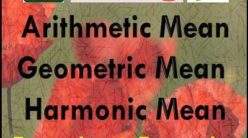In this article explained about some examples with solution of ratio proportion and variation chapter
Ratio proportion and variation formulas and properties Click Here
Ratio and Proportion Questions with Solutions | Quantitative Aptitude
Example-1 : Ratio between two numbers is 5 : 6 and sum of their squares is 244. Then find the numbers
Solution: Let the two numbers be 5a and 6a respectively.
⇒(5a)2 + (6a)2 = 244
⇒25a2 + 36a2 = 244
⇒61 a2 = 244 ⇒ a2 = 4 ⇒ a=2
So the numbers are 5 x 2, 6 x 2
i.e 10 & 12
Example-2 : Find the numbers if the ratio between two numbers is 3 : 7. and their LCM is 210
Solution: Let the numbers be 3a and 7a
LCM is 3 × 7 × a = 210
21a = 210
a = 10
Numbers are 30 and 70.
Example-3 : Find the fourth proportional to 5, 8, 20
Solution: Take fourth proportion is ‘a’
Then 5 : 8 :: 20 : a
According to property of proportions
Product of extreams = Product of means
5a = 160
a = 160/5 = 32
Example-4 : Find the third proportional to 36 & 48
Solution: According to property of proportions, the three quantities x, y & z are in continued proportion
i.e x : y :: y : z are in proportion then y2 = xz
So take third proportion is ‘a” then
36 : 48 :: 48 : a
a = 48 x 48 /36 = 64
Example-5 : If p : q = 5 : 9, q : r = 6 : 8, find p : q : r
Solution: Find the LCM of 9 & 6 is 18
Now the ratio p : q = 5 : 9 = 10 : 18 ( Multiplying with 2 (18/9=2))
Ratio q : r = 6 : 8 = 18 : 24 ( Multiplying with 2 (18/6=3))
Therefore ratio of p : q : r = 10 : 18 : 24
Example – 6 : If a/b = 3/4, then find the value of the expression ( 5a – 3b)/(7a – 2b).
Solution: Here assume the value as a = 3 and b = 4, then
( 5a – 3b)/(7a – 2b) = (15 – 12 ) / (21 – 8) = 3/13
Example – 7 : If 4a = 5b = 3c then find value of a : b : c
Solution: 4a = 5b = 3c then
Now a : b : c = 1/4 : 1/5 : 1/3 = 15/60 : 12/60 : 20/60
a : b : c = 15 : 12 : 20
Example -8 : Find mean proportion of 27 and 3
Solution: We know that
a : b :: b : c are in proportion
b2 = ac
Mean proportion of 27 and 3
= = 9
Example -9 : What much be added to each number 25, 19, 10 and 7 so that resultant numbers are in proportion.
Solution: Let ‘a’ be added to each number then they are in proportion
i.e 25 + a : 19 + a = 10 + a : 7 + a
Now according to property of proportion
Product of extreams = Product of means
So
⇒ ( 25 + a ) ( 7 + a ) = ( 19 + a ) ( 10+ a )
⇒ 175 + 32a + a2 = 190 + 29a + a2
⇒ 3a = 15
⇒ a = 5
Example -10 : If x : y = y : z, then x4 : y4 is equal to
Solution: Here x : y = y : z
Now according to property of proportion
Product of extreams = Product of means
y2 = xz
⇒
Therefore x4 : y4 = x2 : z2
Example-11 : What much be added to the term ratio 5 : 8 so as to make it equal to 1 : 2
Solution: Let ‘a’ be added to ratio of 5 : 8 to make 1 : 2
Then
a = -2
Example – 12 : If a : b = c : d = e : f = 5 : 6 then find the value of
Solution : According property of equal ratios
then
Now according to property of Multiply or divide of ratio
then
Example – 13: Find the value of
Solution: Here all ratios are equal
Now by the property of equal ratio
Example-14 : Two numbers are in the ratio 5 : 6 and if 4 is subtracted from each, they are reduced to ratio 4 : 5. Find bigger number
Solution: Ratio of two numbers is 5 : 6
Let these numbers 5a & 6a
Subtract 4 from each then new ratio 4 : 5
i.e 5a – 4 : 6a – 4 = 4 : 5
⇒ 25a – 20 = 24a – 16
⇒ a = 4
Now these numbers are 20 & 24
So bigger number is 24
Example-15: A bag contain one rupee coins, two rupee coins and five rupee coins in the ratio of 3 : 4 : 5. If there are in all Rs. 288 in the bag, has many coins of one rupee are there?
Solution: Let ‘a’ be added to ratio of 3 : 4 : 5 to make 288 rupees
i.e one rupee coins = 3a , two rupee coins = 4a & five rupee coins = 5a
Now equal the value of all coins
3a + 2 (4a) + 5(5a) = 288
Simplifying the above equation we get
a = 8
Number of one rupee coins = 3 x 8 = 24
Example-16: One milk boy adds 2 liter of water to 12 liter of milk and another 2 liter of water to 10 liter of milk. What is the ratio of strength of milk in the two mixtures?
Solution
Strength of milk in the first mixture
Strength of milk in the second mixture
Therefore ratio of their strengths 12/14 : 10/12
= 12 x 12 : 10 x 14
= 36 : 35
Example-17: One milk boy adds equal quantity of mixture of milk and water in the ratio 9 : 5 and 4 : 3 respectively. Both the mixtures are now mixed thoroughly. Find the ratio of milk to water in the new mixture do obtained?
Solution:Here two mixtures
one is 9 : 5 and another is 4 : 3
take the LCM of 14 (9 + 5) , 7 (4 +3) is 14
Both mixtures are mixed in equal quantities
In first ratio out of 14 liters having 9L milk and 5L of water
Second ratio 4 : 3 = 8 : 6 ( multiplying with 2 for each)
In second ratio out of 14 liters having 8L milk and 6L of water
In the new mixture having 17L ( 9+8) milk and 11L (5 +6) of water
So ratio of new mixture is 17 : 11
Example-18: Two vessels contain quantity of mixture of water and milk in the ratio 1 :2 & 2 : 3 respectively. Both the mixtures are mixed in the ratio of 3 : 1, Find the ratio after mixing the two mixtures.
Solution:Here two mixtures
one is 1 : 2 and another is 2 : 3
take the LCM of 3 (1 +2) , 5 (2 + 3) is 15
Both mixtures are mixed in 3 : 1
So take quantities of first mixture is 45L ( 15 x3) and second mixture is 15 L( 15 x 1)
In first ratio out of 45 liters having 15L water and 30L of milk
In second ratio out of 15 liters having 6L water and 9L of milk
In the new mixture having 21L ( 15 + 6) water and 39L (30+9) of milk
So ratio of new mixture is 21 : 39
i.e 7 : 13
Example-19: If P : Q = 3 : 4 , Q : R = 5 : 9 and R : S = 16 : 15, then ratio between P and S is
Solution: Here First find the ratio of P : Q : R
P : Q = 3 : 4 & Q : R = 5 : 9
P : Q : R = 15 : 20 : 36 ( Multiplying with 5 for the ratio of P : Q & 4 for the ratio of Q : R )
Now equal to the ratios of P : Q : R & R : S ( LCM of both R values of 36 & 16 is 144 )
P : Q : R = 15 : 20 : 36 = 60 : 80 : 144 ( Multiplying with 4 for the ratio of P : Q : R )
R : S = 16 : 15 = 144 : 135 ( Multiplying with 9 for the ratio of R : S )
P : Q : R : S = 60 : 80 : 144 : 135
Ratio of P : S = 60 : 135 = 4 : 9
Example-20 : A person traveling with a constant speed, he took 8 minutes 40 seconds to reach his office and 9 minutes to return, using a different route. Find ratio of the lengths of the two routes.
Solution: We know that D = ST ( D = distance , S = Speed & T = time)
D ∝ S ( If time is constant )
D ∝ T ( If speed is constant )
Now in our case speed is constant so ratio of length is proportional to time
i.e 8 min 40 sec : 9 min
520 : 540 ( converted into seconds)
26 : 27
Example -21: The ratio of present ages of two sisters P, Q is 1 : 2 and 5 years back the ratio was 1 : 3 what will be the ratio of their ages after 5 years?
Solution: Ages of P and Q are 1a & 2b
Now 5 years back the ratio is 1 : 3 so
1a – 5 : 2b -5 = 1 : 3
Simplifying the above ratio3a -15 = 2a -5
a = 10
The ages of P and Q are 10, 20
After 5 years their age 10+5 , 20+5
So the ratio is 15 : 25
i.e 3 : 5
Example – 22 : The ration of P’s salary to Q’s salary is 2 : 3. The ration of Q,s salary to R’s salary is 4 : 5. What is the ration of P’s salary to R’s salary?
Solution: Find LCM of 3 and 4 (Both values are representing to ‘ Q ‘)
The LCM is 12
Now covert ‘ Q ‘ values in each ratio to 12
Thus, Ration – 1 = 2 : 3 = 8 : 12
Ratio – 2 = 4 : 5 = 12 : 15
Thus, P : Q : R = 8 : 12 : 15
Hence P : Q = 8 : 15
Example -23: Ratio of the earning of P and Q is 4 : 7 of the earning of A increased by 50% and those of Q decreases by 25 % the new ratio of their earning becomes
Solution: Let the original earning of P and Q are 4x and 7x
New earning of = 150 % of 4x = 150 x 4x / 100 = 6x
New earning of Q = 75 % of of 7x = 75 x 7x / 100 = 21x/4
Ratio of P and Q after new earning = 6x : 21x/4
Now the above ratio can be written as 8 : 7

Thanks for reading this article. I Hope you liked this article of “ Ratio proportion and variation problems with solutions ”. Give feed back and comments please.
Related Articles
Ratio Proportion and Variation aptitude formulas
Arithmetic Progression Formulas
Geometric Progression formulas
Relation between AM, GM and HM





